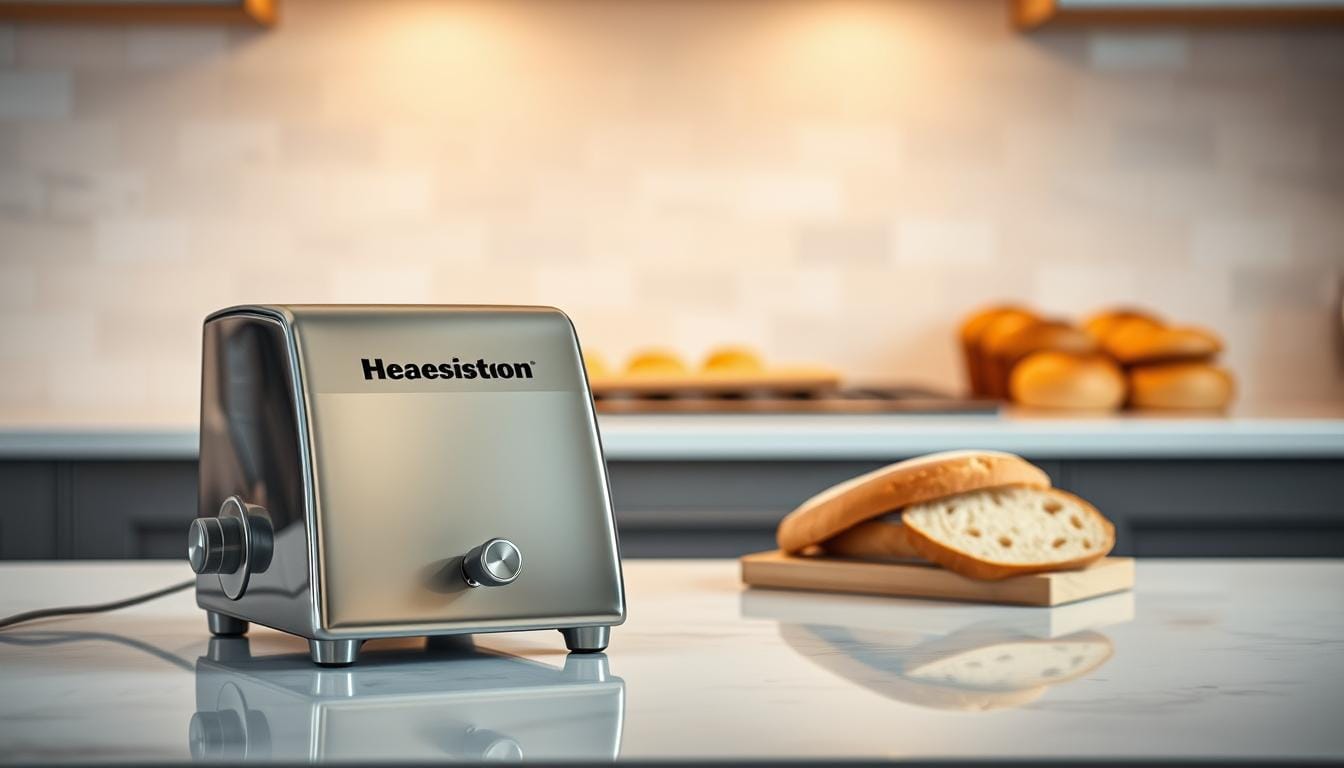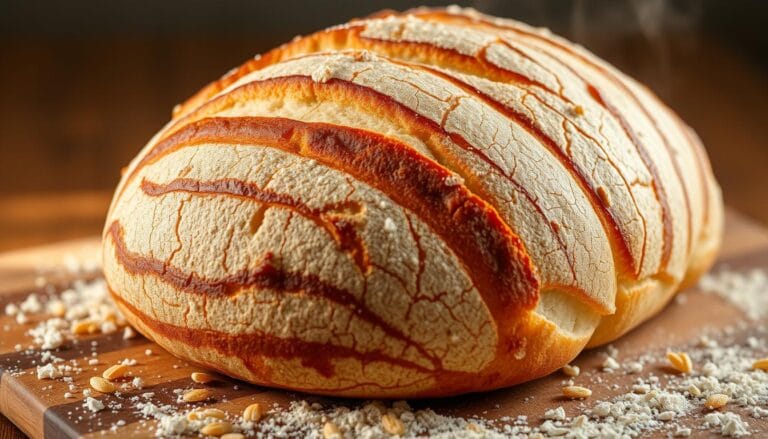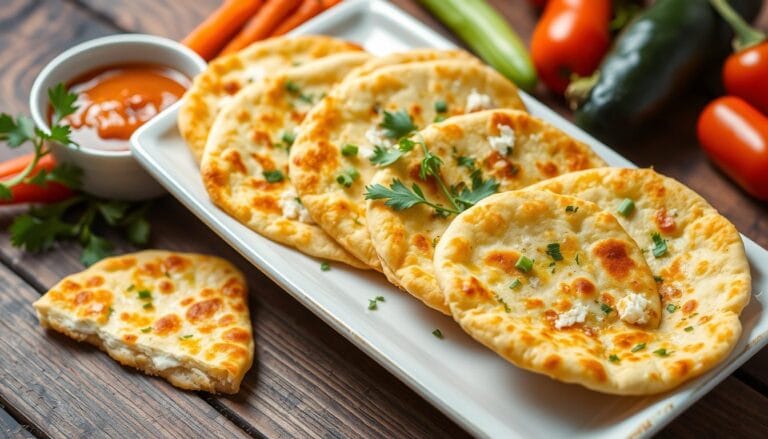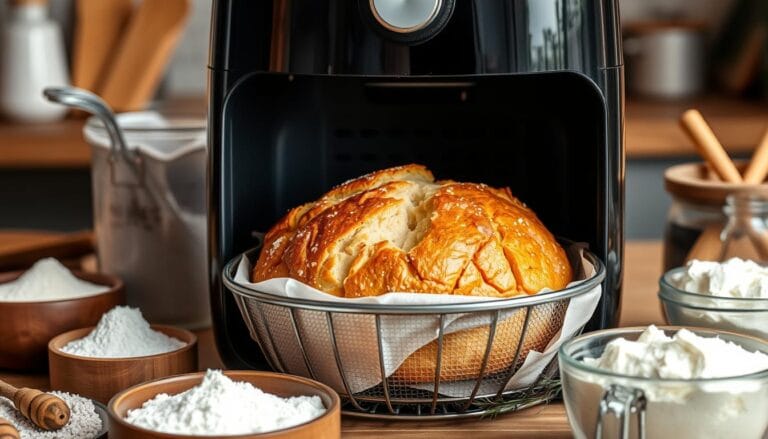Choose the Perfect Bread Slicer for Your Kitchen
Table of Contents
The smell of fresh bread fills your kitchen, bringing back memories of family breakfasts and lazy mornings. When you grab the loaf, you face a challenge: how to slice it right. A bread slicer is your kitchen’s new best friend.
A good bread slicer changes your cooking game, making each slice a masterpiece. Whether you bake at home or just love sandwiches, the right slicer matters. It’s not just about making things easier; it’s about making your meals better with care.
In this guide, we’ll dive into the world of bread slicers. We’ll look at manual and electric options. You’ll learn how to pick the best one for your kitchen, so every slice is perfect. Let’s find the way to slice perfection together.
Understanding the Importance of a Quality Bread Slicer
A quality bread slicer changes your kitchen game. It makes slicing bread easy. It’s great for home bakers and bakery owners alike.
Benefits of Uniform Slicing
Uniform slices are key for a good slicer. They ensure even toasting and look professional. Your sandwiches will look better, and portion control is easy.
Time and Effort Savings
Bread slicers save you time and energy. No more fighting with knives or uneven slices. A good slicer quickly slices loaves, giving you more time for other things.
Professional Results at Home
Get bakery-quality slices at home with a top slicer. You’ll get the same precision as pros. Impress everyone with perfectly sliced bread.
- Create picture-perfect sandwiches
- Slice bread for elegant toast presentations
- Prepare uniform croutons for salads
Investing in quality bread slicers is wise. It improves your bread experience, saves time, and gives you pro results at home.
Types of Bread Slicers Available in the Market
Bread slicers come in many types to fit different needs and budgets. You can find simple manual devices or advanced commercial slicers. Let’s look at the main categories to help you choose the right one for your kitchen.
Manual Bread Slicers
Manual bread slicers are perfect for home use. They’re affordable and easy to use. These slicers have a wooden or plastic base with slots for even cuts.
You’ll need to use some effort, but they’re great for occasional use. Plus, they don’t need electricity.
Electric Bread Slicers
Electric bread slicers are great for quick and easy slicing. They use motorized blades to cut through loaves fast. They’re perfect for daily use in busy homes or small cafes.
Electric slicers give consistent results with little effort. They’re a good choice for regular use.
Commercial Grade Options
Commercial bread slicers are made for big operations. They can handle many loaves at once. They’re key for bakeries and restaurants.
Many commercial slicers are automatic. They let you adjust the slice thickness and have safety features.
| Slicer Type | Best For | Slicing Speed | Price Range |
|---|---|---|---|
| Manual | Home use | Slow | $20-$50 |
| Electric | Daily home/small cafe use | Fast | $100-$300 |
| Commercial | Bakeries/Restaurants | Very Fast | $500-$3000+ |
When picking a bread slicer, think about how often you’ll use it, your space, and your budget. A manual slicer might be enough for occasional use. But, a commercial slicer is needed for lots of slices.
Electric slicers are a good choice for regular use at home or in small businesses.
Key Features to Consider When Buying a Bread Slicer
When picking a bread slicer, some features really matter. Blade quality is key. Look for stainless steel blades that stay sharp and don’t rust. This means clean cuts and a long-lasting slicer.
Being able to adjust the slice thickness is also important. It lets you make slices from thin to thick, fitting your needs and recipes. Some electric slicers even have multiple thickness settings for more control.
Think about the slicer’s capacity too, especially if you slice a lot. Industrial slicers can handle big loaves and lots of slices, perfect for busy kitchens or small businesses. For home use, a compact slicer with good capacity is enough.
Durability is crucial for any kitchen tool. Choose slicers made from sturdy materials like stainless steel or high-quality plastics. These materials last longer and are easier to clean and keep up.
If you have arthritis or find it hard to use your hands, an electric slicer is a good choice. They need less effort and can slice bread fast and evenly. They’re also great for those who slice bread often and want to save time.
- Blade quality (stainless steel preferred)
- Adjustable slice thickness
- Capacity suitable for your needs
- Durable construction
- Electric options for ease of use
By looking at these features, you can pick a bread slicer that fits your needs and improves your kitchen experience.
Safety Features and Design Elements
When picking a professional bread slicer or heavy-duty bread slicer, safety is key. Modern slicers have many safety features to keep users safe from accidents and injuries.
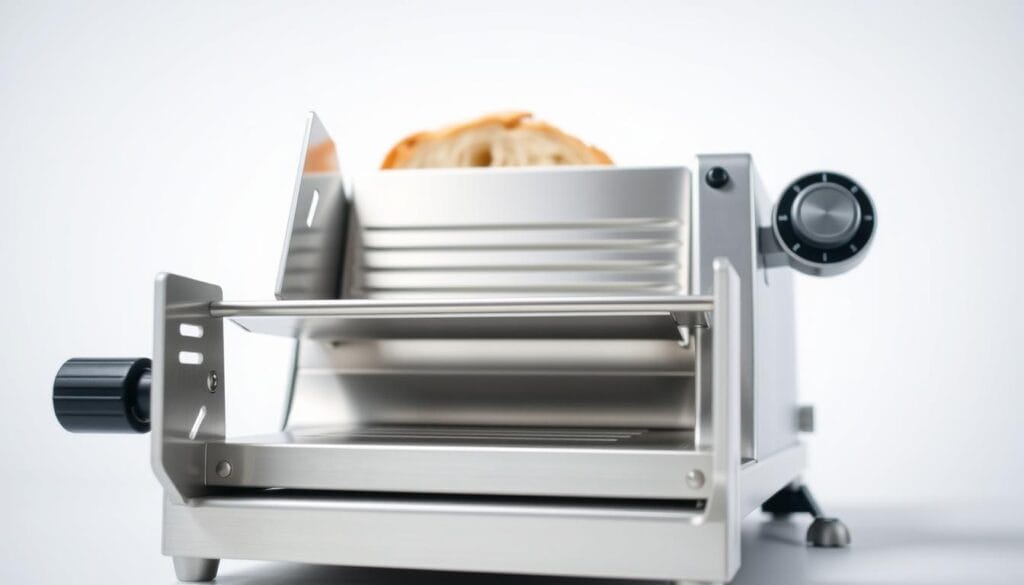
Blade Guards and Protection
Professional bread slicers have blade guards to protect users from sharp blades. These guards cover the blade when not in use and move back during slicing. Some heavy-duty bread slicers have removable blade covers for easy cleaning.
Non-slip Base Components
Stability is important for safe use. Quality bread slicers have non-slip rubber feet or suction cups to keep them steady. This is crucial for heavy-duty bread slicers that handle big loaves or lots of slices.
Emergency Stop Mechanisms
Electric professional bread slicers often have emergency stop buttons. These let users stop the machine quickly if needed. Some models also have automatic shut-off if the cover is opened during use.
By focusing on these safety features, you can have a safe slicing experience in your kitchen or bakery. A well-designed professional bread slicer not only cuts well but also keeps users safe from harm.
Size and Storage Considerations for Your Kitchen
Choosing the right bread slicer is more than just about cutting. Size and storage are key to making it fit well in your kitchen.
For small kitchens, compact bread slicers are perfect. They often fold up for easy storage in cabinets or drawers. Larger slicers, on the other hand, offer more stability and can cut more bread.
Think about your kitchen’s layout when picking a bread slicer. Measure your counter and storage spots to find the best fit. Some slicers even have built-in storage for blades and accessories, saving space.
| Bread Slicer Type | Average Dimensions (L x W x H) | Ideal Kitchen Size |
|---|---|---|
| Compact Manual | 12″ x 7″ x 6″ | Small Apartments |
| Standard Electric | 18″ x 10″ x 12″ | Medium-sized Kitchens |
| Commercial Grade | 24″ x 18″ x 20″ | Large Kitchens, Bakeries |
Foldable bread slicers are great for saving space. Wall-mounted options also keep your counters clear while keeping your slicer handy.
By thinking about size and storage, you’ll find a bread slicer that meets your needs and fits your kitchen perfectly.
Manual vs. Electric Bread Slicer: Making the Right Choice
Choosing between manual and electric bread slicers can be tricky. Let’s explore the key factors to help you make an informed decision for your kitchen needs.
Cost Comparison
Manual bread slicers are more budget-friendly upfront. They cost between $20 and $100. Electric bakery slicers, on the other hand, can cost $100 to $500 or more. Think about how often you’ll use it to decide which is better value.
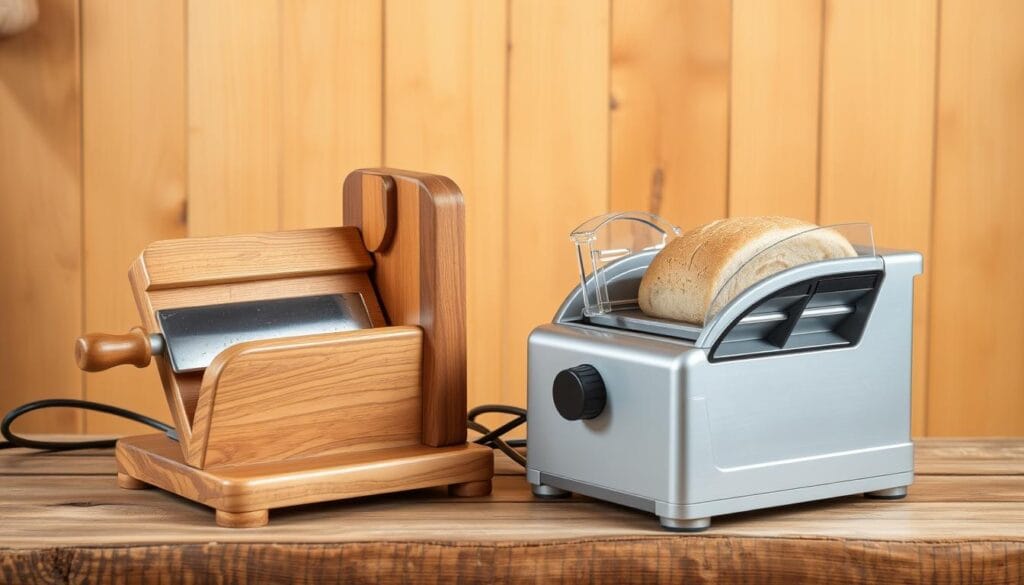
Performance Analysis
Electric bread slicers are faster and more consistent. They can slice a whole loaf in seconds with even thickness. Manual slicers take more effort but let you control the slice thickness. If you need to slice a lot, electric models are better.
Maintenance Requirements
Manual slicers need regular cleaning and occasional blade sharpening. Electric bakery slicers require more upkeep, like lubricating parts and replacing worn-out components. Both need proper storage to keep working well and safely.
| Feature | Manual Slicer | Electric Slicer |
|---|---|---|
| Initial Cost | Lower | Higher |
| Speed | Slower | Faster |
| Consistency | Variable | Uniform |
| Maintenance | Simple | Complex |
Your choice between manual and electric bread slicers depends on your budget, how often you use it, and what you want. Think about these factors to pick the best bakery slicer for you.
Top Brands and Their Unique Selling Points
When choosing a bread slicer, brand reputation matters. Let’s explore some leading names in the industry and what sets them apart.
Oliver Bread Slicers is known for their robust commercial bread slicers. These machines cut bread with precision and last a long time. They’re ideal for busy bakeries and restaurants.
Customers love Oliver’s slicers for their consistent performance and easy maintenance.
For home bakers, Cuisinart’s automatic bread slicers are a hit. They’re compact and fit well on countertops. They make professional-quality slices.
Cuisinart’s slicers have adjustable thickness settings and safety features. Home users really appreciate these.
Berkel is a trusted name in food equipment, offering both manual and electric bread slicers. Their commercial-grade machines have powerful motors and can handle large volumes. Berkel’s slicers often have innovative designs that boost efficiency in professional kitchens.
| Brand | Best For | Key Features |
|---|---|---|
| Oliver | Commercial Use | Durable, Precise Cutting |
| Cuisinart | Home Use | Compact, Adjustable Settings |
| Berkel | Professional Kitchens | Powerful, High Volume |
Remember, the best brand for you depends on your specific needs. Think about slice thickness options, safety features, and maintenance requirements when choosing.
Maintenance and Care Tips for Your Bread Slicer
Keeping your bread slicer in top shape is key to its longevity and performance. Whether you own an industrial bread slicer or an electric bread slicer, proper care ensures you’ll enjoy perfectly sliced bread for years to come.
Cleaning Procedures
Clean your slicer after each use to prevent crumb buildup and maintain food safety. For electric bread slicers, unplug the device before cleaning. Wipe down surfaces with a damp cloth and mild detergent. Use a soft brush to remove stubborn crumbs from hard-to-reach areas.
Blade Maintenance
Sharp blades are crucial for clean cuts. For industrial bread slicers, schedule regular professional sharpening. With electric models, follow the manufacturer’s guidelines for blade care. Some blades can be sharpened at home, while others need replacement.
Storage Recommendations
Store your bread slicer in a dry place to prevent rust. Cover it when not in use to keep dust away. For compact electric bread slicers, consider a dedicated cabinet space. Industrial models should be stored in a clean, accessible area of your kitchen.
- Keep the slicer away from heat sources
- Ensure moving parts are locked before storage
- Store the power cord neatly to prevent damage
By following these care tips, you’ll extend the life of your bread slicer and ensure it’s always ready to deliver perfect slices.
Price Range and Value for Money
Bread slicers vary in price, fitting different needs and budgets. Basic manual slicers start at $20, perfect for home use. Mid-range models, priced between $50 and $150, offer better durability and precision.
For professional-grade equipment, prices range from $200 to $1000. These high-end models provide superior performance and longevity. Heavy-duty bread slicers for commercial use can cost over $1000.
Think about your slicing needs when considering value. If you bake often or run a small bakery, a quality slicer saves time and effort. Look for adjustable slice thickness, easy cleaning, and sturdy construction.
| Price Range | Type | Best For |
|---|---|---|
| $20 – $50 | Basic Manual | Occasional home use |
| $50 – $150 | Advanced Manual | Regular home baking |
| $200 – $1000 | Professional Electric | Small bakeries, cafes |
| $1000+ | Heavy-Duty Commercial | Large-scale operations |
A well-maintained bread slicer can last for years. Consider long-term savings from reduced bread waste and consistent slices. Choose a model that fits your budget and meets your needs.
Common Mistakes to Avoid When Using a Bread Slicer
Using a bread slicer can be tricky if you’re new to it. Let’s look at some common mistakes to avoid when slicing your favorite loaves.
Incorrect Blade Adjustment
One common mistake is setting the blade wrong on your bread slicer. This can lead to uneven slices or even damage to your bread. Always check the blade alignment before use and adjust it for the thickness you want.
Overloading the Slicer
Trying to cut too much bread at once can strain your bread cutting machine. It’s best to slice one loaf at a time, especially for larger or denser breads. This ensures clean cuts and prevents jamming.
Safety Violations
Ignoring safety precautions is a serious error when using a bread slicer. Always use the provided safety guards and keep your hands away from the blade area. Wear cut-resistant gloves if recommended by the manufacturer.
| Mistake | Consequence | Prevention |
|---|---|---|
| Incorrect blade adjustment | Uneven slices, damaged bread | Check alignment before use |
| Overloading the slicer | Jammed machine, poor cuts | Slice one loaf at a time |
| Safety violations | Risk of injury | Use safety guards, wear protective gear |
By avoiding these common pitfalls, you’ll ensure safe operation and get the most out of your bread slicer. Always follow the manufacturer’s guidelines for the best results and longevity of your bread cutting machine.
Conclusion
Choosing the right bread slicer can change your kitchen for the better. It doesn’t matter if you bake at home or run a bakery. A good slicer gives you even slices and saves you time. There’s a perfect slicer for every need and budget, from manual to electric.
When picking a bakery slicer, think about safety, size, and how easy it is to clean. Decide if you prefer a manual or electric model. A reliable slicer means your bread will always be perfectly cut, making your baking look professional.
Looking at your needs and the options available will help you find the best bread slicer. With the right one, you’ll get perfectly cut bread every time. This will make your cooking and daily meals even better.

